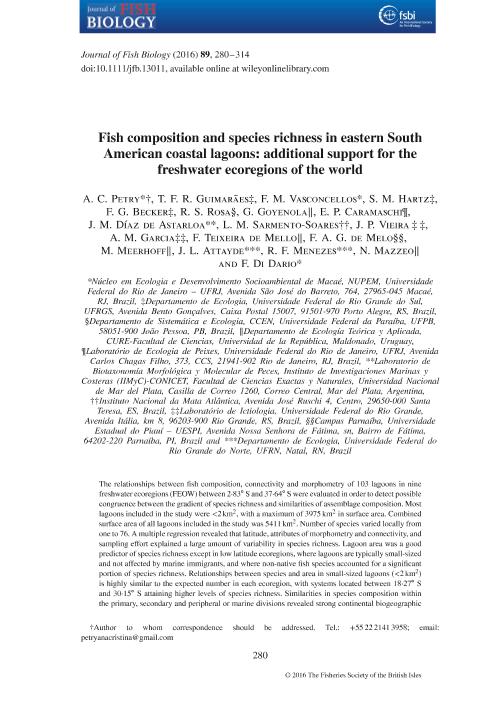Artículo
Fish composition and species richness in eastern South American coastal lagoons: additional support for the freshwater ecoregions of the world
Petry, A. C.; Guimarães, T. F. R.; Vasconcelos, F. M; Hartz, S. M.; Becker, F. G.; Rosa, R. S.; Goyenola, G.; Caramaschi, E. P.; Díaz de Astarloa, Juan Martín ; Sarmento Soares, L. M.; Vieira, J. P.; García, A. M.; Teixeira de Mello, Franco; de Mello, F. T.; Meerhoff, M.; Attayde, J. L.; Menezes, R. Fernandes de; Mazzeo, N.; Di Dario F.
; Sarmento Soares, L. M.; Vieira, J. P.; García, A. M.; Teixeira de Mello, Franco; de Mello, F. T.; Meerhoff, M.; Attayde, J. L.; Menezes, R. Fernandes de; Mazzeo, N.; Di Dario F.
 ; Sarmento Soares, L. M.; Vieira, J. P.; García, A. M.; Teixeira de Mello, Franco; de Mello, F. T.; Meerhoff, M.; Attayde, J. L.; Menezes, R. Fernandes de; Mazzeo, N.; Di Dario F.
; Sarmento Soares, L. M.; Vieira, J. P.; García, A. M.; Teixeira de Mello, Franco; de Mello, F. T.; Meerhoff, M.; Attayde, J. L.; Menezes, R. Fernandes de; Mazzeo, N.; Di Dario F.
Fecha de publicación:
07/2016
Editorial:
Wiley Blackwell Publishing, Inc
Revista:
Journal of Fish Biology
ISSN:
0022-1112
e-ISSN:
1095-8649
Idioma:
Inglés
Tipo de recurso:
Artículo publicado
Clasificación temática:
Resumen
The relationships between fish composition, connectivity and morphometry of 103 lagoons in nine freshwater ecoregions (FEOW) between 2·83° S and 37·64° S were evaluated in order to detect possible congruence between the gradient of species richness and similarities of assemblage composition. Most lagoons included in the study were <2 km(2) , with a maximum of 3975 km(2) in surface area. Combined surface area of all lagoons included in the study was 5411 km(2) . Number of species varied locally from one to 76. A multiple regression revealed that latitude, attributes of morphometry and connectivity, and sampling effort explained a large amount of variability in species richness. Lagoon area was a good predictor of species richness except in low latitude ecoregions, where lagoons are typically small-sized and not affected by marine immigrants, and where non-native fish species accounted for a significant portion of species richness. Relationships between species and area in small-sized lagoons (<2 km(2) ) is highly similar to the expected number in each ecoregion, with systems located between 18·27° S and 30·15° S attaining higher levels of species richness. Similarities in species composition within the primary, secondary and peripheral or marine divisions revealed strong continental biogeographic patterns only for species less tolerant or intolerant to salinity. Further support for the FEOW scheme in the eastern border of South America is therefore provided, and now includes ecotonal systems inhabited simultaneously by freshwater and marine species of fishes.
Palabras clave:
CONNECTIVITY
,
FEOW
,
NEOTROPICS
,
SALINITY TOLERANCE
,
SPECIES-AREA RELATIONSHIP
Archivos asociados
Licencia
Identificadores
Colecciones
Articulos(IIMYC)
Articulos de INSTITUTO DE INVESTIGACIONES MARINAS Y COSTERAS
Articulos de INSTITUTO DE INVESTIGACIONES MARINAS Y COSTERAS
Citación
Petry, A. C.; Guimarães, T. F. R.; Vasconcelos, F. M; Hartz, S. M.; Becker, F. G.; et al.; Fish composition and species richness in eastern South American coastal lagoons: additional support for the freshwater ecoregions of the world; Wiley Blackwell Publishing, Inc; Journal of Fish Biology; 89; 1; 7-2016; 280-314
Compartir
Altmétricas



